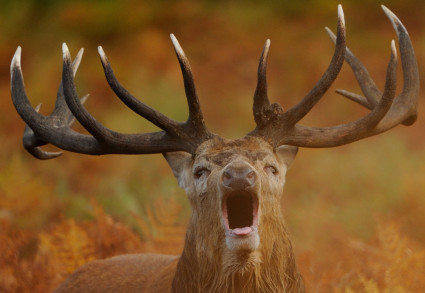Red deer

Status
Native and common
Population
350,000
Scientific name
Cervus elaphus
Red deer are the largest wild terrestrial mammal in Britain. The males have spectacular antlers, which branch out and can span up to 1m wide. They shed them every winter. The size and complexity of the antlers increase as the stag gets older. They are rarely used as weapons but more as a status symbol. Red deer have reddish-brown fur in summer, which becomes grey-brown in winter. Red deer normally live in small single-sex herds and get together in autumn when the rutting season begins. Stags are very noisy during the rut and their bellowing can be heard from half a kilometre away. Females are solitary when giving birth, but then gather into herds with their young and non-breeding males.
Shoulder height: 110 – 120cm
Weight: Up to 225kg
Lifespan: Up to 25 years
Reproduction
The rut, or mating season, lasts for about a month in early autumn. Usually a single calf is born in May or June, but twins are frequent in good habitats. The calf is born with white spots on its fur, but these disappear within a few weeks.
Diet
Leaves, grasses, heather, rushes and tree bark, especially in the winter.
Habitat
Forests, particularly conifer plantations in Scotland, but also open hillsides and moorland especially in Scotland and the Pennines.
Predators
No natural predators in the UK.
Threats
They are culled in some areas, particularly as they can cause damage to commercial tree plantations. Calves are vulnerable to cold and wet winters.
Status & Conservation
Native and common
Population size & distribution
GB population 350,000 (England, 12,000; Wales, fewer than 500). The population has remained unchanged over the last 10 years. They are widely distributed in Scotland (mainly present on hill land) and are present on some of the Scottish islands. In England, there are populations in the south west (including the New Forest), Cumbria, the Peak District, Hampshire and East Anglia. They are commonly kept in deer parks throughout the country. Small populations occur in Ireland.
Did you know?
Red deer stags in woodlands and grasslands in the south of England usually produce larger antlers with more points than those feeding on poorer vegetation in the uplands of northern Britain.
